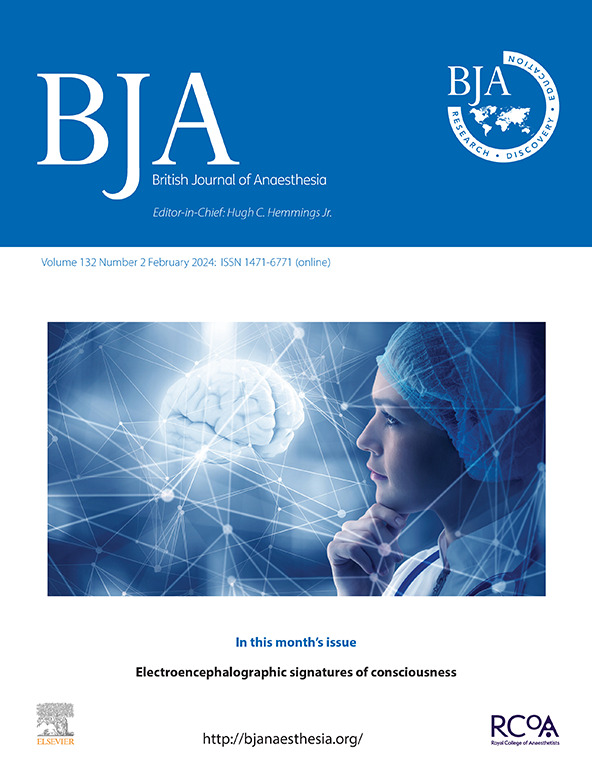Impact of superficial and deep parasternal blocks on recovery after cardiac surgery with sternotomy: a randomised controlled trial.
IF 9.2
1区 医学
Q1 ANESTHESIOLOGY
引用次数: 0
Abstract
BACKGROUND Pain is common after cardiac surgery and can impair recovery. Regional anaesthesia has been proposed to limit pain, but its impact on recovery is unknown. This study compared the impact of superficial or deep parasternal intercostal plane blocks (SPIP or DPIP) in addition to standard care vs standard care alone on postoperative quality of recovery (QoR) after cardiac surgery with sternotomy. METHODS In this single-centre, randomised, single-blind, controlled trial, adult patients undergoing cardiac surgery with sternotomy were randomly assigned to one of three groups (with a 1:1:1 allocation ratio): control group (standard care without regional anaesthesia), SPIP group, or DPIP group. The primary endpoint was QoR assessed using a French validated version of the Quality of Recovery-15 questionnaire at 24 h after surgery. Secondary outcomes included postoperative pain scores, analgesic consumption, ICU and hospital length of stay, and adverse events. RESULTS Between July 1, 2022, and August 30, 2023, we randomised 254 patients (81.1% men, 65.5 [27-85] yr). The French validated version of the Quality of Recovery-15 scores did not significantly differ between any parasternal block group (SPIP or DPIP) and the standard care group (P=0.248). Postoperative pain and analgesic consumption were similar across groups, with low pain scores (median [interquartile range] 24-h numerical rating scale: 2.0 [3.0-0.0]). There were more pneumothoraces in the DPIP group (P=0.032). No significant differences were observed for other complications. CONCLUSIONS Regional anaesthesia by parasternal intercostal plane blocks after sternotomy did not improve QoR at 24 h compared with standard care. CLINICAL TRIAL REGISTRATION NCT05345639.浅层和深层胸骨旁阻滞对胸骨切开术后心脏手术恢复的影响:一项随机对照试验。
背景:心脏手术后疼痛是常见的,并且会影响康复。局部麻醉已被提议用于限制疼痛,但其对恢复的影响尚不清楚。本研究比较了浅层或深层胸骨旁肋间平面阻滞(SPIP或DPIP)加上标准护理与单独标准护理对胸骨切开术心脏手术术后恢复质量(QoR)的影响。方法在这项单中心、随机、单盲、对照试验中,接受胸骨切开手术的成年患者被随机分为三组(按1:1:1的分配比例):对照组(标准治疗,不进行区域麻醉)、SPIP组或DPIP组。主要终点是在术后24小时使用法国验证版的恢复质量-15问卷评估QoR。次要结局包括术后疼痛评分、镇痛药用量、ICU和住院时间以及不良事件。在2022年7月1日至2023年8月30日期间,我们随机分组了254例患者(81.1%为男性,65.5[27-85]岁)。法国验证版的恢复质量-15评分在任何胸骨旁阻滞组(SPIP或DPIP)和标准护理组之间没有显着差异(P=0.248)。术后疼痛和镇痛药消耗各组相似,疼痛评分较低(24小时数值评定量表中位数[四分位数范围]:2.0[3.0-0.0])。DPIP组气胸发生率高于对照组(P=0.032)。其他并发症无显著差异。结论与标准治疗相比,胸骨切开术后胸骨旁肋间平面阻滞区域麻醉不能改善24 h QoR。临床试验注册号:nct05345639。
本文章由计算机程序翻译,如有差异,请以英文原文为准。
求助全文
约1分钟内获得全文
求助全文
来源期刊
CiteScore
13.50
自引率
7.10%
发文量
488
审稿时长
27 days
期刊介绍:
The British Journal of Anaesthesia (BJA) is a prestigious publication that covers a wide range of topics in anaesthesia, critical care medicine, pain medicine, and perioperative medicine. It aims to disseminate high-impact original research, spanning fundamental, translational, and clinical sciences, as well as clinical practice, technology, education, and training. Additionally, the journal features review articles, notable case reports, correspondence, and special articles that appeal to a broader audience.
The BJA is proudly associated with The Royal College of Anaesthetists, The College of Anaesthesiologists of Ireland, and The Hong Kong College of Anaesthesiologists. This partnership provides members of these esteemed institutions with access to not only the BJA but also its sister publication, BJA Education. It is essential to note that both journals maintain their editorial independence.
Overall, the BJA offers a diverse and comprehensive platform for anaesthetists, critical care physicians, pain specialists, and perioperative medicine practitioners to contribute and stay updated with the latest advancements in their respective fields.

 求助内容:
求助内容: 应助结果提醒方式:
应助结果提醒方式:


